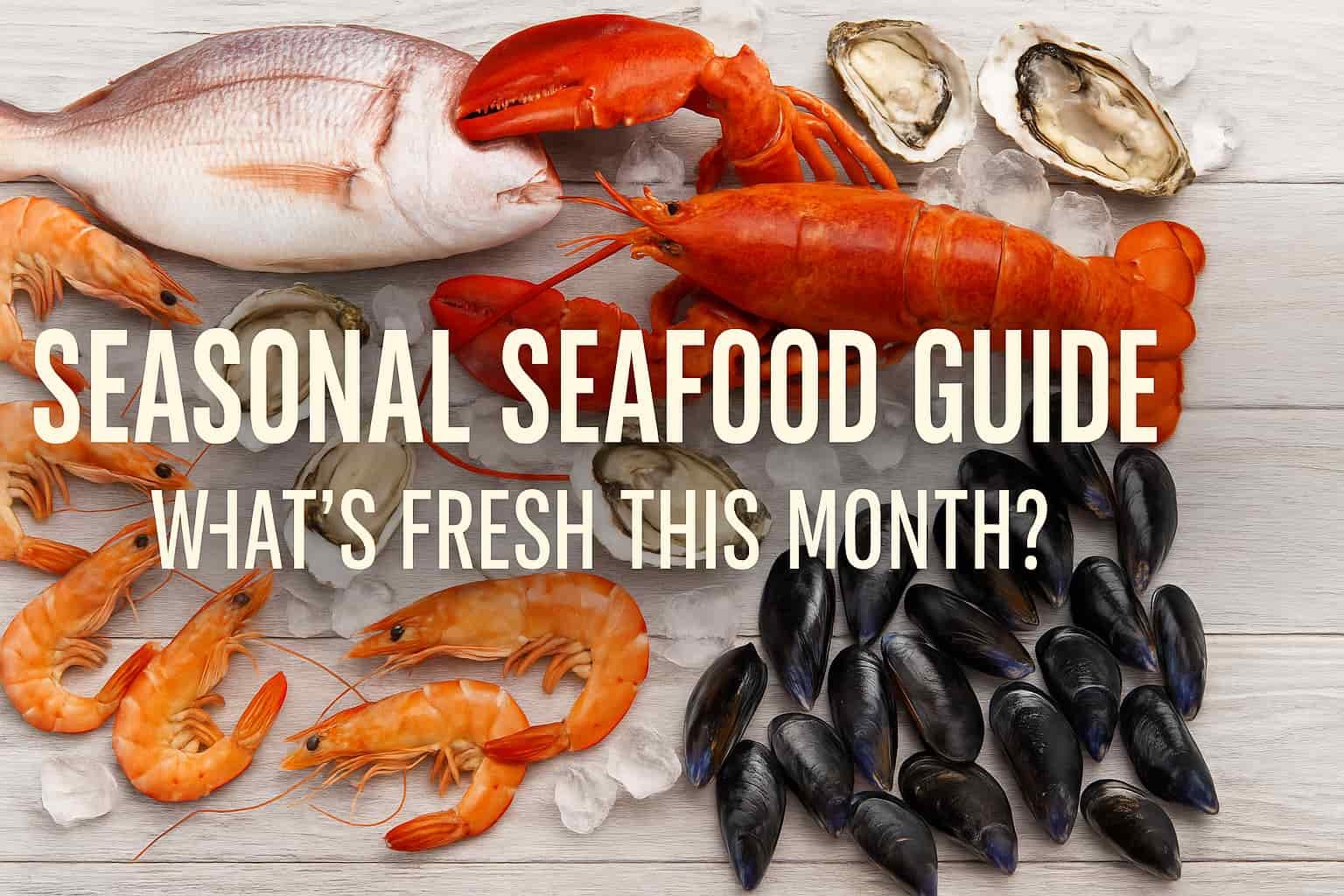Seafood lovers know that not all fish are created equal—especially when it comes to freshness. Choosing seafood that’s in season not only ensures the best flavor and texture, but also supports more sustainable fishing practices and can help you save money. Just like fruits and vegetables, different seafood varieties have peak seasons when they’re more abundant and at their best.
This seasonal seafood guide is your month-by-month companion to what’s fresh, local, and delicious throughout the year. Whether you’re shopping at your neighborhood fishmonger, planning a special dinner, or just looking to eat more sustainably, knowing what’s in season can elevate your seafood experience. Let’s dive in and discover what the ocean has to offer each month!
Contents
- 1 Why Eat Seasonal Seafood?
- 2 How Seafood Seasonality Works
- 3 January: Cold-Water Gems
- 4 February: Bold Flavors for Winter Meals
- 5 March: A Fresh Shift Toward Spring
- 6 April: Spring Seafood Awakens
- 7 May: Wild Salmon and Blue Crab Shine
- 8 June: Lobster, Tuna, and Anchovies Arrive
- 9 July: Summer Favorites in Full Swing
- 10 August: Warm-Water Variety and Bold Tastes
- 11 September: A Transition into Autumn
- 12 October: Briny Delights and Cold-Water Richness
- 13 November: Comforting Catch for Cooler Days
- 14 December: Luxurious Choices for the Holidays
- 15 How to Buy and Store Seasonal Seafood
- 16 Tips for Cooking Seasonal Seafood at Home
- 17 Conclusion: Eat Smarter, Eat Fresher
Why Eat Seasonal Seafood?
Eating seafood in season is a win-win—for your taste buds, your wallet, and the environment. Here’s why it’s worth paying attention to the calendar when choosing your seafood:
- Better Taste and Texture: Fresh, in-season seafood is at its peak flavor, harvested at just the right time.
- Lower Prices: When seafood is abundant, prices drop. You’ll often get more value for your money during peak seasons.
- Supports Local Economies: Seasonal seafood is often locally sourced, which helps sustain coastal communities and their fishing industries.
- Eco-Friendly Choices: Harvesting seafood during the right seasons reduces overfishing and allows fish populations to replenish naturally.
If you’re interested in learning more about how your seafood choices impact the planet, check out our article on What Is Sustainable Seafood and Why It Matters.
How Seafood Seasonality Works
Unlike fruits and vegetables that follow seasonal weather patterns, seafood seasonality is largely influenced by factors such as water temperature, spawning cycles, migration patterns, and regional regulations. These elements determine when certain fish and shellfish are at their peak, both in flavor and in population size.
For example, wild salmon is most plentiful in the summer months during its migration, while oysters are traditionally best in colder months. In addition, seafood harvested from wild sources will have stricter seasonal windows than farmed varieties. Understanding these natural rhythms helps you make informed choices and enjoy seafood as nature intended.
January: Cold-Water Gems
The new year kicks off with a bounty of cold-water seafood at its peak. Oysters are especially delicious this time of year, thanks to the chill that keeps their flavor briny and clean. Dungeness crab is another winter favorite, with tender, sweet meat that shines in everything from crab cakes to simple steamed presentations. Mussels are also in season and affordable, perfect for cozy winter stews or quick skillet dishes with white wine and garlic.
When shopping, look for shellfish with tightly closed shells and a fresh, oceanic smell. January is an excellent time to start exploring the rich, hearty side of seafood cuisine.
February: Bold Flavors for Winter Meals
February continues the winter seafood celebration with a mix of firm, flavorful options. Clams are abundant and pair beautifully with pasta or chowders. Rockfish, with its mild but slightly sweet flavor, is great for pan-searing or baking. You’ll also find sea bass in season, ideal for delicate recipes that highlight its buttery texture.
This is a great month to experiment with heartier seafood dishes that warm you up from the inside out. Don’t forget to check out our guide on How to Store and Freeze Seafood Safely to keep your purchases fresh and ready for any midweek meal.
March: A Fresh Shift Toward Spring
As winter begins to fade, March brings lighter seafood options that signal the shift toward spring. Halibut becomes more widely available—its mild flavor and firm texture make it a versatile choice for roasting or grilling. Scallops are still in season, offering sweet, buttery bites that cook up quickly for elegant dinners. Mackerel, a flavorful oily fish, is also plentiful and provides a great source of omega-3s.
This month is a great time to start transitioning your meals toward fresher, brighter flavors while still enjoying the richness of cold-season seafood.
April: Spring Seafood Awakens
April marks the arrival of springtime seafood that’s light, tender, and quick to cook. Shrimp are coming into season and are especially versatile—try them grilled, sautéed, or added to fresh salads. Snapper, known for its lean flesh and mild flavor, is perfect for baking whole or serving with citrusy sauces. You’ll also start to see more squid (calamari) in markets, great for quick frying or adding to pasta.
This month’s seafood pairs beautifully with spring vegetables like asparagus, peas, and fresh herbs. It’s a perfect time to embrace lighter dishes and refresh your cooking routine.
May: Wild Salmon and Blue Crab Shine
May is a favorite month for seafood lovers as wild salmon season begins. Rich in flavor and nutrients, wild salmon is best when grilled, roasted, or pan-seared with simple herbs and lemon. Blue crab also comes into season and is ideal for crab boils, cakes, or simply steamed with Old Bay seasoning. Sardines, often overlooked, are at their freshest and richest now—try them grilled whole or preserved in olive oil.
Eating seafood in May offers a perfect combination of flavor and nutrition, as ocean harvests become more active with warmer waters.
June: Lobster, Tuna, and Anchovies Arrive
As summer approaches, June brings a wave of indulgent and flavorful catches. Lobster season kicks off, making it a great time to enjoy lobster rolls, steamed tails, or buttery grilled halves. Tuna, especially yellowfin, is also in peak season—ideal for seared steaks or poke bowls. Anchovies are plentiful and shine in salads, pizzas, or as umami-rich additions to sauces.
June’s seafood bounty makes it easy to celebrate with bold, summery meals. Be sure to ask for wild-caught or sustainably sourced options when possible to get the best flavor and support responsible fishing.
July: Summer Favorites in Full Swing
July is peak season for some of the most beloved seafood options of the year. Alaskan salmon is at its freshest, particularly sockeye and king varieties—both known for their rich color and flavor. Mahi-mahi, a tropical fish with a mild, slightly sweet taste, is ideal for grilling or tacos. This month also brings soft-shell crab, a delicacy perfect for frying whole and serving in sandwiches or on top of salads.
With warm weather and summer gatherings in full swing, July is the perfect time to fire up the grill and enjoy seafood alfresco. Combine fresh seafood with seasonal fruits like mango or pineapple for a refreshing twist.
August: Warm-Water Variety and Bold Tastes
In August, seafood markets offer a vibrant variety of warm-water fish. Swordfish is a standout this month—its firm, meaty texture holds up well on the grill and pairs beautifully with bold marinades. Grouper, a lean, mild fish, is popular for baking or broiling with herbs and butter. Clams make a return in abundance and are great steamed with white wine or added to pasta dishes.
This is a great month to try new recipes and take advantage of flavorful, robust catches that pair well with grilled vegetables and chilled white wine.
September: A Transition into Autumn
As summer winds down, September brings a gentle shift toward cooler-weather seafood. Mussels are once again plentiful and perfect for steaming with garlic, herbs, and broth. Haddock, a flaky white fish, is ideal for chowders or pan-frying. Shrimp continues to be in season and remains a versatile favorite for quick weeknight meals or crowd-pleasing appetizers.
September’s seafood offers a great balance between summer freshness and the heartier meals of fall, making it a transitional month full of flavorful possibilities.
October: Briny Delights and Cold-Water Richness
As the weather cools, October welcomes seafood that’s best enjoyed in the fall. Oysters return to their peak with a plump, clean flavor thanks to colder waters—ideal for raw platters or baked preparations. Halibut remains in season, making it a go-to for hearty, satisfying meals like roasted fillets or fish stews. King crab also makes its seasonal appearance, offering rich, sweet meat perfect for steaming or adding to pasta dishes.
This is a great month to start adding warming flavors and buttery sauces to your seafood dishes, aligning with the cozy comfort of autumn cooking.
November: Comforting Catch for Cooler Days
November offers a solid mix of fish that shine in warm, comforting dishes. Sea trout, with its delicate, flaky flesh, is perfect for pan-searing or baking with herbs. Cod, a cold-water classic, is ideal for chowders, fish and chips, or baked with lemon and breadcrumbs. Scallops also make a return, bringing their signature sweet flavor and elegant presentation to your holiday table.
As the holiday season approaches, November seafood lends itself well to both weeknight simplicity and celebratory feasts.
December: Luxurious Choices for the Holidays
December is all about indulgence and celebration, and the seafood reflects that mood. Lobster returns to center stage, ideal for lavish dinners, pasta, or surf-and-turf meals. Monkfish, often called “the poor man’s lobster” due to its firm, meaty texture, is great in stews or oven-roasted. Arctic char, a cold-water fish similar to salmon and trout, rounds out the list with its delicate flavor and beautiful pink flesh.
Whether you’re planning a festive dinner or looking for something special to end the year, December offers some of the most luxurious seafood options of the year.
How to Buy and Store Seasonal Seafood
Choosing seafood that’s in season is only half the journey—knowing how to properly buy and store it ensures you get the most flavor and the longest shelf life.
At the Market:
- Smell: Fresh seafood should smell like the ocean—clean and briny, not fishy or sour.
- Eyes and Gills: For whole fish, look for clear eyes and bright red gills.
- Texture: Fish fillets should be firm, not mushy or slimy. Shellfish should have tightly closed shells.
- Source: Ask your fishmonger where and how the seafood was caught to ensure it aligns with your sustainability values.
Storage Tips:
- Short-Term: Keep seafood cold by storing it on a bed of ice in your fridge. Use within 1–2 days for best quality.
- Freezing: Wrap fish tightly in plastic or vacuum-seal, then freeze. Shellfish should be cleaned and stored in airtight containers.
- Cooked Seafood: Store leftovers in the refrigerator and consume within 2–3 days.
Need more guidance? Read our in-depth article on How to Store and Freeze Seafood Safely.
Tips for Cooking Seasonal Seafood at Home
Cooking seafood doesn’t have to be complicated. Once you’ve chosen what’s fresh this month, here are some tips to bring out its best:
- Keep it simple: Let the seafood shine. Use olive oil, herbs, lemon, and light seasoning.
- Match the method: Grill hearty fish like swordfish or tuna, steam delicate ones like cod or flounder, and bake shellfish for even cooking.
- Pair with seasonal produce: Spring herbs, summer citrus, autumn root vegetables, and winter greens all complement seafood beautifully.
- Don’t overcook: Most seafood cooks quickly. Use a thermometer or watch for visual cues like opaque flesh and easy flaking.
These little details can turn a simple fish fillet into a standout dish.
Conclusion: Eat Smarter, Eat Fresher
Eating seasonal seafood is one of the easiest ways to enjoy better-tasting meals while making eco-conscious choices. From succulent summer salmon to briny winter oysters, every month offers something unique and delicious from the sea.
Bookmark this guide and return each month to plan your meals around what’s freshest. And don’t forget to ask your local fishmonger what’s in season near you—your taste buds and the planet will thank you.



